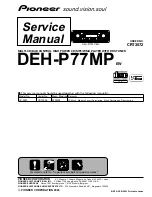
9
DRAWMER
1974 O
PERATOR’S
M
ANUA
L
LOW-MID
FREQUENCY:
55Hz - 2.1kHz
See 3
BANDWIDTH:
0.33 - 3.3 Octaves
Bandwidth is defined as the range of frequencies (width)
centred around that set by the frequency knob allowing you
to attenuate or boost a very narrow or wide range of frequencies
within each EQ band.
On the 1974 the width of the effected signal is measured as
Bandwidth (as opposed to ‘Q’, which it is inversely related to) and on the Low-Mid and High-Mid bands are fully
parametric (as opposed to semi, quasi or fixed that you may find on other eq’s) meaning that the bandwidths
are fully adjustable across their entire range providing greater control.
CUT/BOOST:
-12dB - +12dB
See 3
HIGH-MID
FREQUENCY:
400Hz - 14kHz
See 3
BANDWIDTH:
0.33 - 3.3 Octaves
See 4
CUT/BOOST:
-12dB - +12dB
See 3
HIGH
FREQUENCY:
1.2kHz - 20kHz
See 3
SLOPE:
6dB / 12dB
Sets by how much or ‘fast’ the signal is attenuated in dB’s per octave
at the High frequencies. 6dB per octave is more gentle and therefore
more musical than 12dB, however, at 12dB per octave the signal is
‘focused’ but attenuation more noticeable.
CUT/BOOST:
-12dB - +12dB
See 3
HIGH CUT
FREQUENCY:
4kHz - 32kHz
This continually variable control attenuates the signal above the frequency set. The rate
at which the attentuation occurs is set by the ‘Slope’ control set in the High band (see 6).
Use it to remove extraneous content at the higher end of the audio range such as hiss,
taming an overly bright instrument or separating bleed when recording drums.
IN:
This Bypass switch, when pushed in will illuminate the LED, indicating that the High Cut
Filter is in circuit.
POWER
BYPASS
Off - On
A hard-wire bypass will bypass the 1974 when active.
POWER LED
Will illuminate when the unit has power and is switched on via the switch on the rear.
O/L LED
Will illuminate when the stereo signal is 6dB bellow the maximum output. If this occurs lower the
Input gain control to suit.
5
6
7
8
4
































